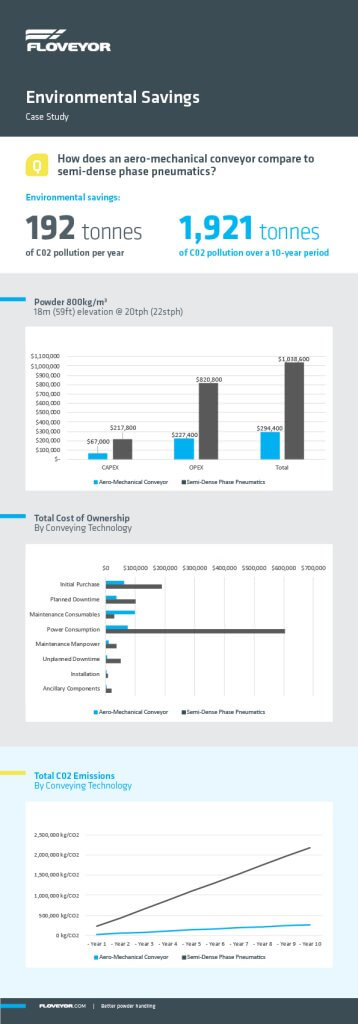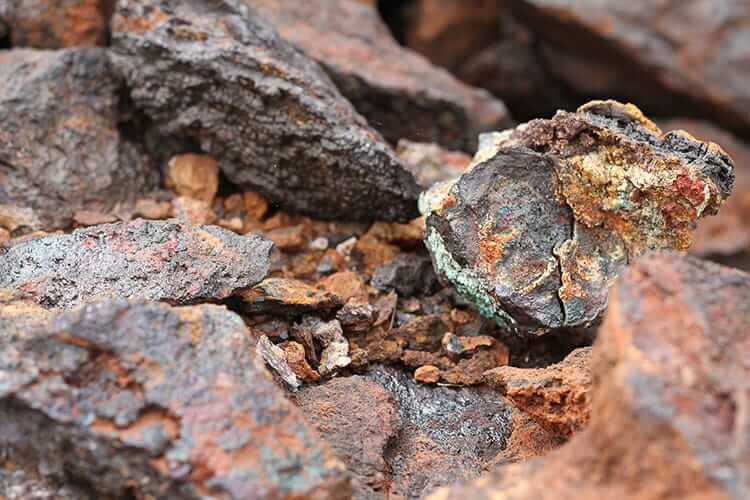Mining companies have no choice but to give attention to environmental, social and governance (ESG) issues. Increased scrutiny from all stake holding groups – including the board, shareholders, the public, and employees – impacts a company’s social licence to operate (SLO). Critical minerals used in battery manufacturing are a key part of the transition to green energy, but miners are still expected to optimise their mining operations to make them as ESG compliant as possible.
Mining conveyor systems can play a big part in circularity and ESG for critical minerals like lithium hydroxide (LiOH), especially when it comes to:
- CO2 emissions
- energy efficiency
- product wastage
- product integrity
- water usage.
Using the right conveying system for critical minerals can reduce costs, increase yields, and improve the environmental impact of your mining operations.
Case study: aero-mechanical conveyor vs pneumatic conveyor
Consider what happens when you replace a pneumatic conveyor, commonly found in mining applications, with an aero-mechanical conveyor (AMC). There are multiple ways your ESG impact improves. We’ve highlighted some of the main areas where an AMC outperforms a pneumatic conveyor.

Energy usage
Increasingly, energy efficiency is one of the top reasons people select an aero-mechanical mining conveyor system for their critical minerals powder handling. Not only is an AMC more effective at reducing environmental impact, the energy savings directly translates to reduced electricity costs, especially when compared to a pneumatic conveying system. For example, at an average Australian rate of $0.34/kWh, an AMC saves miners more than $50,000/year in operational expenses from each conveyor used in a mining operation.
Carbon emissions
A Floveyor AMC with FloDisc® technology is incredibly energy efficient for the same conveying capacities of a semi-dense phase pneumatic conveyor. In this example, when transferring materials at 20,000 kg/hr, the AMC runs on a 5.5 kW drive. The pneumatic conveyor requires a 45 kW drive. Using an Australian blended rate of 0.65 kg/kWh for C02 emissions from electricity generation, the benefits to the environment are rapidly realised.
Every mining operation is unique and C02 emissions from electricity generation can differ, but the AMC has a greater impact on sustainability. With over 6,000 installations on record, Floveyor’s global impact on reducing C02 emissions is substantial.
Additional ESG Improvements when using aero-mechanical conveyors
There’s no doubt carbon emissions and energy usage are the most significant contributor to improved ESG when using an AMC over a semi-dense phase pneumatic conveyor. AMC systems outperform many other mining conveying systems when it comes to issues like product wastage, contamination, and water.
Product wastage
Another way to improve sustainability and contribute to circularity in mining is through design. An AMC with FloDisc® techonlogy ensures total batch transfers and the gentle handling of materials for a better yield. That means minimal, if any, material is left in the conveyor at the end of a run. Breakage and damage to the crystalline structure of critical minerals like lithium hydroxide monohydrate are also minuscule. Miners have little or no product wastage, which can be substantially beneficial both financially and environmentally.
Contamination
Contamination is eliminated with the AMC design. For critical minerals and metals used in battery manufacturing, ferrous contamination or CO2 contamination is disastrous. The fully enclosed tubes used in AMC systems help meet the contamination requirements of the battery material industries that are magnitudes stricter than more traditional mining applications.
By contrast, bucket elevators have a lot of moving parts which pose a risk for contamination. A chain conveyor, also called a drag chain conveyor, while used in many heavy chemical and industrial applications, is not recommended for critical minerals processing used for batteries. While both a drag chain conveyor and a bucket elevator can be enclosed, contamination can occur by contact with the chain and buckets.
Water
In most instances aero-mechanical conveyors can be dry cleaned with inert gas purging – if they need cleaning at all. No water is required to clean Floveyor conveyors.
Floveyor aero-mechanical conveying systems
The sustainability benefits and ESG contributions of aero-mechanical conveying outperform other conveying systems like bucket elevators and drag chain conveyors. A Floveyor aero-mechanical conveying system provides multiple environmental efficiencies, preserves product integrity, and increases yields. With increasing regulations to reduce carbon emissions and rising energy costs, a Floveyor AMC can provide competitive advantage while helping meet ESG initiatives.
Recycling critical minerals like lithium hydroxide
The next big challenge for battery manufacturing is how to recycle the critical minerals used in EV batteries. An aero-mechanical conveying system is the ideal choice to handle recovered powders. Volumes will be lower than in midstream processing and Floveyor has conveying machinery in multiple sizes to handle both large and small capacity requirements. Both an aero-mechanical conveyor and a tubular drag conveyor are perfectly suited to handle bulk materials of critical minerals recovered during battery recycling operations.
Meet us at the Critical Minerals Conference in Perth
Floveyor is exhibiting at the AusIMM Critical Minerals Conference 2023 in Perth on 21-23 November. Visit us at stand 12 to have an in-person discussion about powder handling for your critical minerals.
Get in touch with Floveyor for advice on powder handling for your critical minerals operation. As powder handling specialists with a long history in both mining and chemical processing, we can give you advice on how mining conveyor systems impact ESG.

